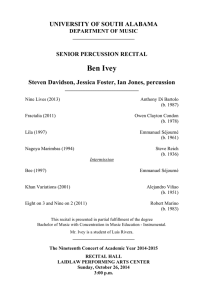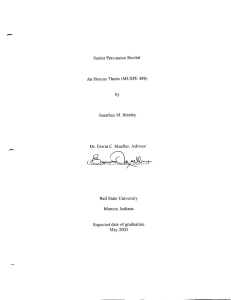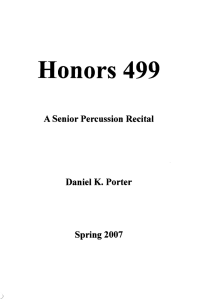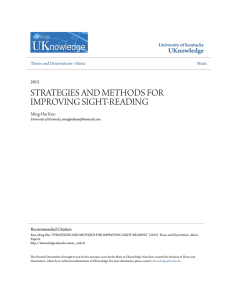Senior Percussion Recital
advertisement
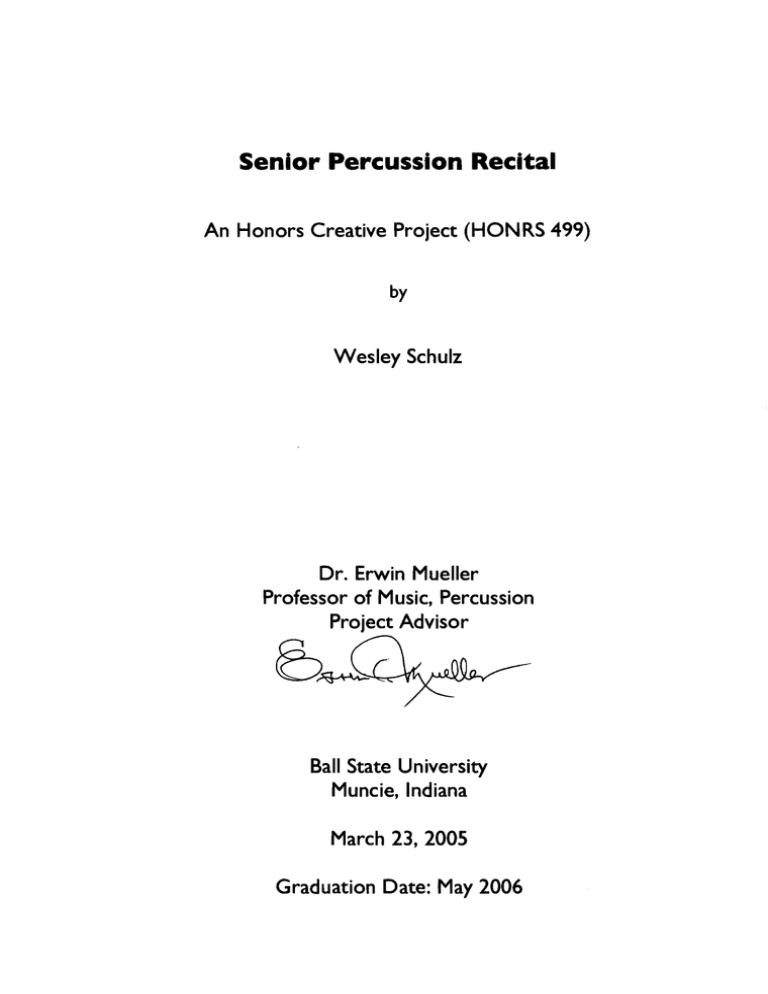
Senior Percussion Recital An Honors Creative Project (HONRS 499) by Wesley Schulz Dr. Erwin Mueller Professor of Music, Percussion Project Advisor E>~ Ball State University Muncie, Indiana March 23, 2005 Graduation Date: May 2006 Abstract The presentation of a senior recital signifies the capstone of four or five years of study as a music performance major. As a double major in Music Education and Percussion Performance, this recital is offered as a demonstration of all that I have learned as a percussionist since the beginning of my studies with Dr. Erwin Mueller at Ball State. Unlike any other instrument, percussion encompasses an almost limitless array of musical instruments that must be mastered. Whereas a pianist or cellist must only learn to play the piano or cello, percussionists must learn to be timpanists, mallet players, drummers, world percussion experts, and more. The literature that I have chosen for my recital encompasses the main areas of percussion that I have studied with Dr. Mueller. In giving this recital I will perform a marimba concerto, a blues vibraphone solo, a snare drum solo, and a timpani solo. As music is not only about playing by oneself, but with others, I will present a percussion trio work for xylophone, marimba and piano, and also a duo piece for two high grade marimba players. Acknowledgements -I want to thank Dr. Erwin Mueller for not only being my professor and teacher, but my mentor and friend. I am indebted to him for his kindliness and patience throughout the past four years. -I would also like to thank all of those who performed with me on this recital: Stacey Scott and Daniel McCloud, pianos; and Camron Momeni and Gabe (Bomba) Penrod, marimbas. -My parents and family I thank most of all. Without their love, financial help, and unending support for my musical endeavors, I would not be where I am today. My thanks and love go to my mom and dad, brother Joshua, and sister Mackenzie. WESLEY SCHULZ percussion SENIOR HONORS RECITAL with Stacey Scott, piano and Gabrielle Penrod and Cameron Momeni, marimba Daniel McCloud, plano Concerto No.2 for Marimba and Orchestra, Op. 25 ......... Nebojsa Jovan Zivkovic I. Introduzione, iniziazinoe dellegno (b.1962) II. Notturno III. Concitato e molto febbrile ... Intermission ... Eight Pieces for Four Timpani ............................................................ Elliott Carter VIII. March (b.1908) Blues for Gilbert .......................................................................... Mark Glentworth (b.1960) ANBA ............................................................................... Nebojsa Jovan Zivkovic Douze Etudes pour Caisse-Claire ............................................ Jacques Delecuse No.9 (b.1933) Ultimatum II ...................................................................... Nebojsa Jovan Zivkovic Wesley Schulz is a student of Erwin Mueller and the recipient of a Young Artist Award. This recital is presented in partial fulfillment of the requirements for the Honors Program at Ball State University. PRUIS HALL Wednesday, March 23, 2005 5:30 p.m. Series LlX Number 151 In keeping with copyright and artist agreements, use of recording and photographic devices is not permitted by other than approved personnel. We request your cooperation. For performance Information, call the School of Music Concert HotLine: 765.285.5678 Wesley Schulz percussion in a Senior Honors Recital Program Notes A Word on the Program •.. Different from all other instrument mediums in which a single instrument is studied. "percussion" refers to a wide range o(instruments. Unlike a pianist or cellist, who must master only the piano or cello respectively. a percussionist must learn to be a timpanist, mallet player~ rudimental and concert snare drummer. world drummer. and so much more. As such. this recital is given to demonstrate the varying a~ of percussion I have studied in my four years at Ball State. In terms of percussion literature. solo works have largely only been written in the last iifty to sixty years. Demonstrative of this is th.e fact that every composer on tonight's program is still living. Addition"Uy. in glancing at the program one will notice a composer that is especially featured. Serbianborn Nebojfa Jovan ~vkOvi~ is one the most prominent and endearing of the current composers/performers in percussion. Born in 1962, many of ~ivkovic's works have already entered the standard repertOry of some of the most talented percussionists. What fascinates me about his music is his aggressive energy and incredible use of rhythm. In addition to these qualities, many of his works, such as ANBA and lIijas. contain wonderfullY lyrical. yet contemplative melodies. Through my years at Ball State I have studied many wOrks by Zivkovit due to my fascination with his composition style. Tonight I am pleased to play for you three of my most favorite works by him. Concerto No.2 for Marimba and Orchestra... NeboJia Jovan tlVkovlc (b. I 962) , Commissioned by the Yamaha Foundation and premiered by the composer in April of 1997. with the Munich Symphony Orchestr:I!J this concerto is one of the most virtuosic and difficult of Zivkovit's works. In composing the concerto. 2:ivkovi~ sought to unite the quintessence of Nature with ~rchaic ek;lments (rhythm as the primal origin of all music. as the force that gives birth to music). Theatrical qualities and a new articulation of tonality combined with the "classical" tonal language are fundamental to this work. Almost thirty minutes in length, the work represents a kind of ritual in which the marimbist is;accepted into a community after a ritual of initiation. The first movement translates "Initiation of the Wood." The second movement is a night scene in which the Initiate undergoes "exhaustioh by dancing." In the finale, the longest and most highly charged movement of the work. the soloist competes with the orchestra on ' various levels of technical proficiency involving polyrhythm and polymeter. As with many works byfivkovi~, this piece hasrecendy made it onto the Ii~ for $Orne of the most prestigious marimba competitions such as the International Marimba Concerto Competition in ljublijana.Slovenia and the International Marimba Competition Unz. This year I won first prize in the Kokomo Symphony Orchestra's Concerto' Competition. As part of the prize. 1performed the third movement with the Kokomo Symphony in concert March 12. 2005. ' Eight Pieces for Four Timpani, VIII. March...................Elllott Carter (b. 1908) Originally written and published as "Six Pieces for Four Ketdedrums," this suite of timpani solos by Elliott Carter was composed as a rhythmiC study for his "String Quartet #1." In 1965 Carter worked with timpanist Jan Williams to revise the work for republication induding two flew pieces. The revised version was published in 1966 and includes many specific instructions for the player. For example. no more than fQUr of the eigbt pieces should be performed at once, and the performer should choose the order. The piece I will play, VIII March, uses a unique compositional technique: metric modulation. In this piece the meter changes constandy throughout.. but the underlying pulse remains the same. In this manner, the pulse transforms into the eighth. triplet.. or sixteenth note, for example. as the meter dictates. The beginning and end of this movement is in the same meter. If all the metric modulations are = executed precisely, the tempo of the opening of the piece and the end will be the same ,(quarter lOS). Note two other interesting aspects of the piece: using the butts of the sticks as welt as the heads. and mutes used at the end. Blues for GUbert............................................ ~ ••••••• Mark Glentworth (b~ 1960) This solo work for Vibraphone was composed in 1983. Mark Glentworth's initial study of percussion began with Prof. GHbert Webster at the Manchester College of Music. When Glentworth heard of Webster's death, he composed this piece in his memory. While not a formal blues<omposition. this piece is Glentworth's attempt to express his mood in reaction to his teacher's death. ,AN BA....................................................................... Nebojl. Jovan tavk.oYll Although the title seems to hold little meaning, a subtitle to the piece is included on the music: "Tanz der kleinen Schwarzen Hexe," or "Dance of the Uttle Black Witch." Written for percussion trio ' (xylophone, marimba, and piano). Zivkovi~ wrote this piece when he was just eighteen years old. Quite a contrast in style to his Concerto. this work is quite short and set in seven-eight time. Uvely throughout, this piece is tonal and delightful to play. Douze Etudes pour CaIsse-Claire, No. 9 •••••••••••••••Jacques Delecluse (b. 1933) Pt,blished in 1964. this set of twelve etudes in the concert style for snare drum has long been a part of audition lists for universities and orchestras. as well as been a staple of l'8Citals. The composer notes in the music that the studies are "only difficult as far as metronomic markings. shading, accents and bindings." In other words. creating music on a single pitched drum(!) These etudes are not meant for beginners. but serve those with more technical ability to correct or improve on foils, rhythms, and steadiness in tempo. lJltJlII;atIJlIt,JI .....................~ ••••••••••••••••••••••••••••••••••••••• NtaltcJJiIlJC»";ara ~1fItc)~ This duo for two players of equal importance is highly virtuosic and rh)'thmical. To the listener, this work often sounds like an ambitious and demanding competition between the two players. Ira Prodanov . writes ohhe work "The piece is based on a combination of atonality and e)J(t.remefy expressive postmodern tqnality and is therefore probably close to everyone's ear even though some of the virtuosically energetic strokes required by the composer may sound rough and contel1'lp()rary. The piece consists of three movements played ottaca. The first, written in the low register•.isbased on Intense octavemelodies from both/players followed by incredibly powerful chords and rapid demisemiquavers. The second movement consists of a long-voiced melody which builds up from the low register, surrounded quite 'ra]n.;like' improvisation in a high register. performed by player one. A downward glissando leads into the third movement, an 'angry whip' in which player one performs an energetic solo above the constant 14116 rhythm. After reaching a climax, both players meet each other and play a unison 'break up' of the high tension of this wildness." Enjoy! bY Acknowle=ments -I want to thank Dr. Erwin Mueller for not only being my professor and teacher. ~ut my mentor and friend. I am Indebted to him for hi$kindliness and patience throughout the past four years. -I would also like to thank all of those who performed with me on this recital: Stacey Scott and Daniel McCloud, pianos; and Camron Momeni and Gabe (Bomba) Penrod. marimbas. -My parents and family I thank most of all. Without their love, financial help. and unending support for . my musical endeavors. I would not be where I am today. My thankS and love go to my mom and dad, brother Joshua, and sister Mackenzie. -Programs notes were written using material from Duson Mihalek, Ira Prodanov. and Jan Williams. Additional information was lifted (Tom notes induded with the printed music.
